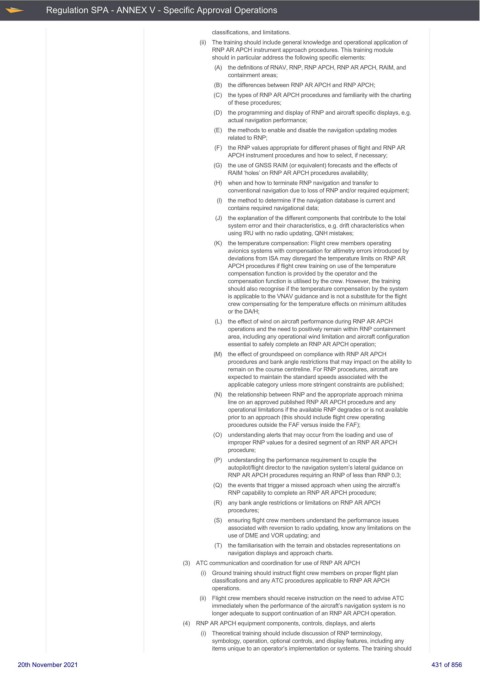Page 431 - UK Air Operations Regulations (Consolidated) 201121
P. 431
~
~ Regulation SPA - ANNEX V - Specific Approval Operations Centrik
classifications, and limitations.
(ii) The training should include general knowledge and operational application of
RNP AR APCH instrument approach procedures. This training module
should in particular address the following specific elements:
(A) the definitions of RNAV, RNP, RNP APCH, RNP AR APCH, RAIM, and
containment areas;
(B) the differences between RNP AR APCH and RNP APCH;
(C) the types of RNP AR APCH procedures and familiarity with the charting
of these procedures;
(D) the programming and display of RNP and aircraft specific displays, e.g.
actual navigation performance;
(E) the methods to enable and disable the navigation updating modes
related to RNP;
(F) the RNP values appropriate for different phases of flight and RNP AR
APCH instrument procedures and how to select, if necessary;
(G) the use of GNSS RAIM (or equivalent) forecasts and the effects of
RAIM ‘holes’ on RNP AR APCH procedures availability;
(H) when and how to terminate RNP navigation and transfer to
conventional navigation due to loss of RNP and/or required equipment;
(I) the method to determine if the navigation database is current and
contains required navigational data;
(J) the explanation of the different components that contribute to the total
system error and their characteristics, e.g. drift characteristics when
using IRU with no radio updating, QNH mistakes;
(K) the temperature compensation: Flight crew members operating
avionics systems with compensation for altimetry errors introduced by
deviations from ISA may disregard the temperature limits on RNP AR
APCH procedures if flight crew training on use of the temperature
compensation function is provided by the operator and the
compensation function is utilised by the crew. However, the training
should also recognise if the temperature compensation by the system
is applicable to the VNAV guidance and is not a substitute for the flight
crew compensating for the temperature effects on minimum altitudes
or the DA/H;
(L) the effect of wind on aircraft performance during RNP AR APCH
operations and the need to positively remain within RNP containment
area, including any operational wind limitation and aircraft configuration
essential to safely complete an RNP AR APCH operation;
(M) the effect of groundspeed on compliance with RNP AR APCH
procedures and bank angle restrictions that may impact on the ability to
remain on the course centreline. For RNP procedures, aircraft are
expected to maintain the standard speeds associated with the
applicable category unless more stringent constraints are published;
(N) the relationship between RNP and the appropriate approach minima
line on an approved published RNP AR APCH procedure and any
operational limitations if the available RNP degrades or is not available
prior to an approach (this should include flight crew operating
procedures outside the FAF versus inside the FAF);
(O) understanding alerts that may occur from the loading and use of
improper RNP values for a desired segment of an RNP AR APCH
procedure;
(P) understanding the performance requirement to couple the
autopilot/flight director to the navigation system’s lateral guidance on
RNP AR APCH procedures requiring an RNP of less than RNP 0.3;
(Q) the events that trigger a missed approach when using the aircraft’s
RNP capability to complete an RNP AR APCH procedure;
(R) any bank angle restrictions or limitations on RNP AR APCH
procedures;
(S) ensuring flight crew members understand the performance issues
associated with reversion to radio updating, know any limitations on the
use of DME and VOR updating; and
(T) the familiarisation with the terrain and obstacles representations on
navigation displays and approach charts.
(3) ATC communication and coordination for use of RNP AR APCH
(i) Ground training should instruct flight crew members on proper flight plan
classifications and any ATC procedures applicable to RNP AR APCH
operations.
(ii) Flight crew members should receive instruction on the need to advise ATC
immediately when the performance of the aircraft’s navigation system is no
longer adequate to support continuation of an RNP AR APCH operation.
(4) RNP AR APCH equipment components, controls, displays, and alerts
(i) Theoretical training should include discussion of RNP terminology,
symbology, operation, optional controls, and display features, including any
items unique to an operator’s implementation or systems. The training should
20th November 2021 431 of 856

